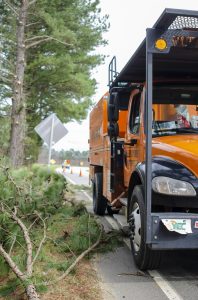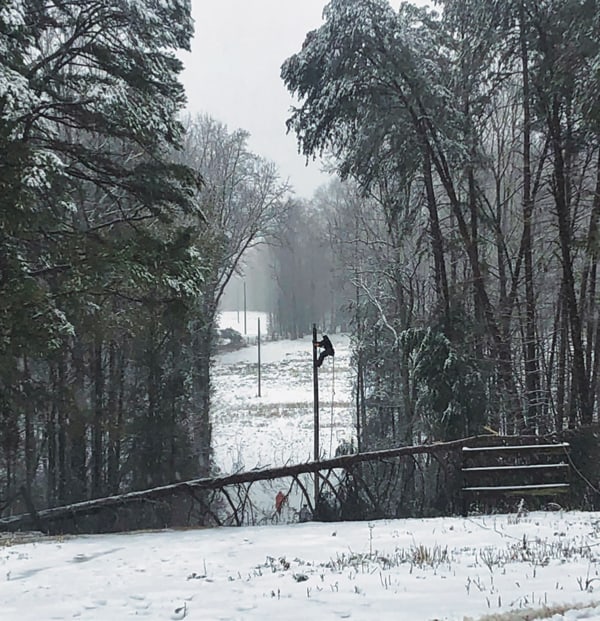Right of Way Maintenance
Right-of-way (ROW) maintenance is one way YEC controls the delivery of safe and reliable electric service. Clearing limbs and trees away from power lines not only helps to prevent outages and blinking lights, it also reduces many potential hazards. To “cut back” on potential tree-related problems, YEC operates an aggressive ROW maintenance program.
What We Do
YEC uses a system-wide integrated ROW management program that includes various mechanical methods as well as the utilization of low-volume herbicide applications.

YEC uses different mechanical methods for clearing the ROW, cutting new trees, and sidewalling adjoining trees. You have probably seen our maintenance contract crews’ vehicles with telescoping boom and saw-type cutter heads trimming trees, mowing or using chainsaws to clear corridors beneath our power lines.
Because keeping the lights on is our primary goal, crews are clearing the trees that could grow into the overhead power lines that deliver electricity to you and your neighbors. Did you realize vegetation, trees, shrubs and brush growing too close to power lines and distribution equipment leads to approximately 15 percent of power interruptions?
While the ROW looks nice after it is trimmed, a mature root system remains beneath the surface. This system will issue root extensions that quickly become new saplings. Since we can’t cut the entire ROW every year, trees may be 6 to 10 feet by the time the crews return. It’s a job that’s never done – by the time crews finish trimming activities along our 2,000 miles of overhead distribution lines, vegetation has started to grow back at the starting point. Therefore, YEC’s ROW efforts are ongoing throughout the year.
Along with the trimming efforts, YEC has another strategy for maintaining ROW. In some areas, YEC uses an environmentally safe herbicide to convert wooded corridors to greenways, which are dominated by flowers, grasses, ferns, and shrubs.
Keeping safety and service reliability in mind for our member and our employees, YEC’s operations department is always seeking to improve its’ ROW program by developing the most economical approach of controlling unwanted vegetation while being environmentally friendly at the same time.
Why Do We Trim Trees?

Safety First & Always
A very important reason for keeping the ROW clear is SAFETY. Accidents happen so quickly. Kids climbing trees can be a tragedy waiting to happen if they touch a limb in contact with an energized line or touch the line itself. The result can be severe injury or even death. Adults also are at risk if working around lines in trees. Power lines can carry up to 34,500 volts and can be deadly. Never touch an electrical wire; always assume it is conducting electricity and is dangerous.
YEC, like all utility companies, is required by and willingly complies with National Electric Safety Code industry standards to keep trees out of power lines for safety reasons.
If you are planning to trim or remove a tree near any power or service line, please contact us at (803) 684‑4248 or via our Contact page. Trained personnel can identify potential reliability or safety threats and advise you on what can be done.
We Trim Trees for Reliability
We all appreciate trees. They beautify our property, cool our homes, provide privacy screens, and even sometimes increase our property value if placed properly.
We also appreciate electricity, although sometimes we take it for granted. We expect reliable electric service. Unfortunately, trees and power lines are not a good mix. Trees growing in power lines can cause blinks and power outages.
Trees falling into power lines due to high wind or ice storms can knock power out to hundreds of members in a second. Not only do lines come down, but utility poles will snap due to the weight of fallen trees causing lengthy power outages. Pruning trees is only a temporary solution because the trees will grow back. Therefore, trees must be permanently cleared using mechanical clear-cutting and spraying methods. Not all storm-related outages can be prevented, but we can certainly minimize the damage by keeping the ROW clear. So when you see ROW contract crews out clearing trees, please remember their work is helping YEC provide reliable service.


We Trim With Storm Restoration in Mind
After a storm, YEC’s priority is to restore power to our members as quickly and safely as possible. We will clear downed trees and limbs that interfere with our power lines and equipment to facilitate safety and service restoration. However, in storm restorations, debris will be left on the premises. Crews will not be returning for clean-up. This is the responsibility of the member.
YEC Needs Your Help
In working to keep a safe, reliable, and affordable supply of power flowing to your home or business, we need your help. Let us know if you notice trees or branches that might pose a risk to our power lines.
Just as important, before planting trees in your yard, think about how tall they may grow and how wide their branches may spread. As a rule of thumb, 25 feet of ground-to-sky clearance should be available on each side of our utility poles to give power lines plenty of space. Choose tree varieties with care and plant with power lines in mind.

How We Keep You Informed
The ROW maintenance schedule is always available here on our website and is often published in South Carolina Living magazine.
FAQ
Right of Way Maintenance FAQ
ROW refers to the corridor or pathway an electric line follows, whether it’s along the road or through the woods. ROW provides utility crews with access to lines for improvements, maintenance, and repairs. It also provides an operational safety zone between the electric lines and trees, buildings, etc. On the majority of its lines, York Electric holds easements that give it the right to clear land 15 feet from either side of the wire.
A clear ROW minimizes outages, improves power quality, reliability, and safety.
- Causes power outages
- Causes lights to blink
- Obstructs visual inspections, making repairs difficult and costly
- Blocks access for maintenance and repairs, causing delays
- Wastes electricity by drawing it to the ground
- Becomes a fire hazard
- Becomes a safety hazard for utility workers and members
- Children and adults should never climb, trim, or touch trees that contact power lines!
York Electric’s ROW maintenance program balances the preservation of natural habitats against the service reliability needs of our members and the safety needs of the general public. In fact, it can actually benefit the ecosystem and other natural environments. ROW maintenance efforts create open areas that encourage the growth of wildflowers, ferns, grasses, flowers, berries, and other low-growing shrubs.
